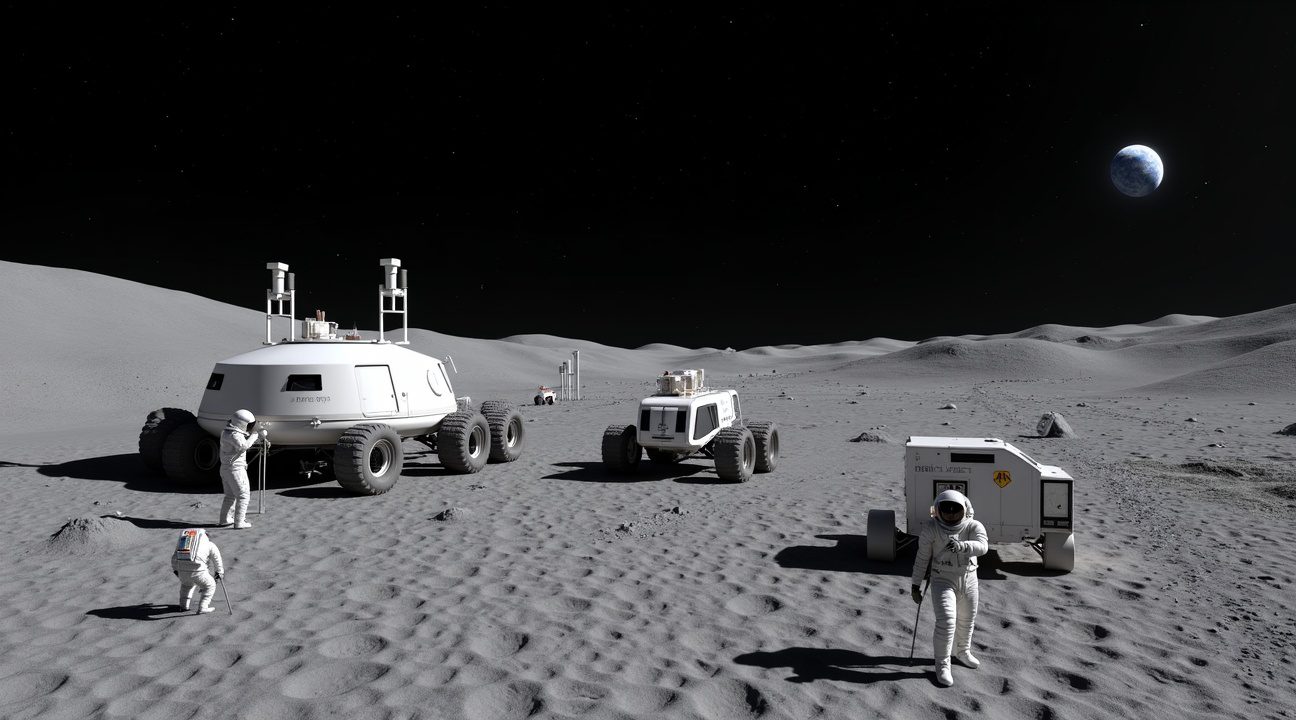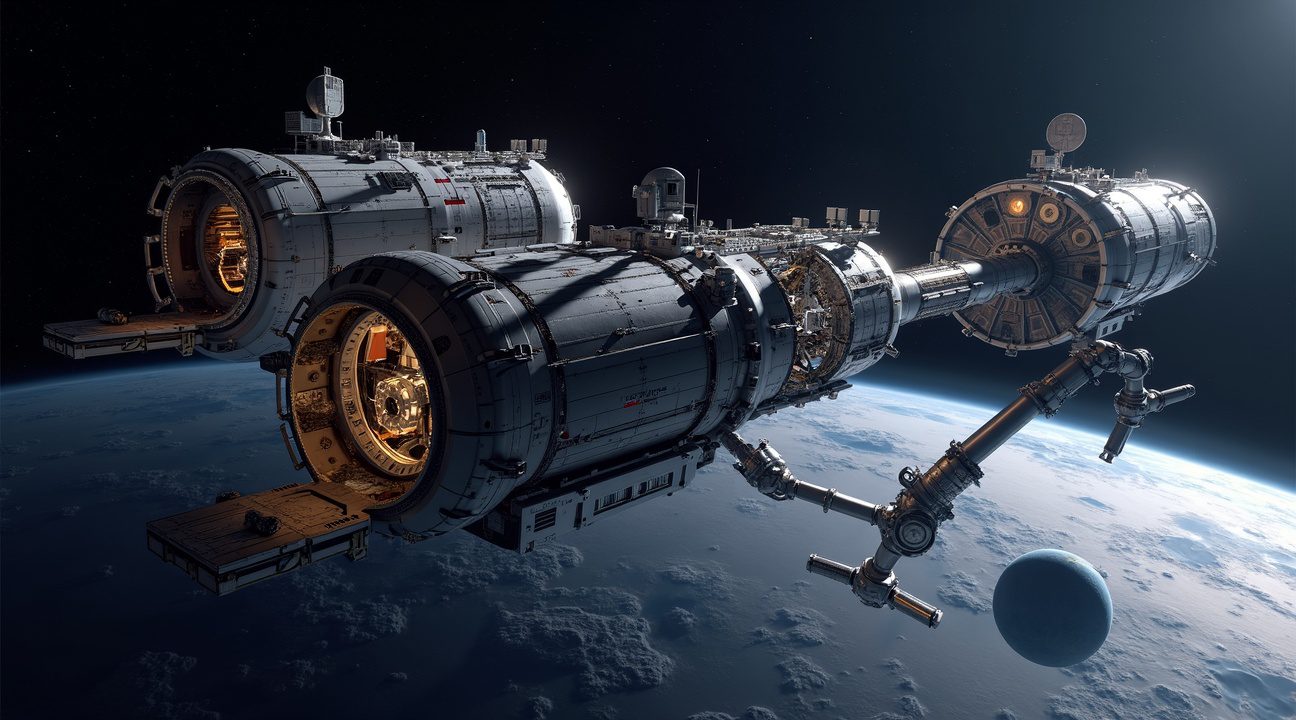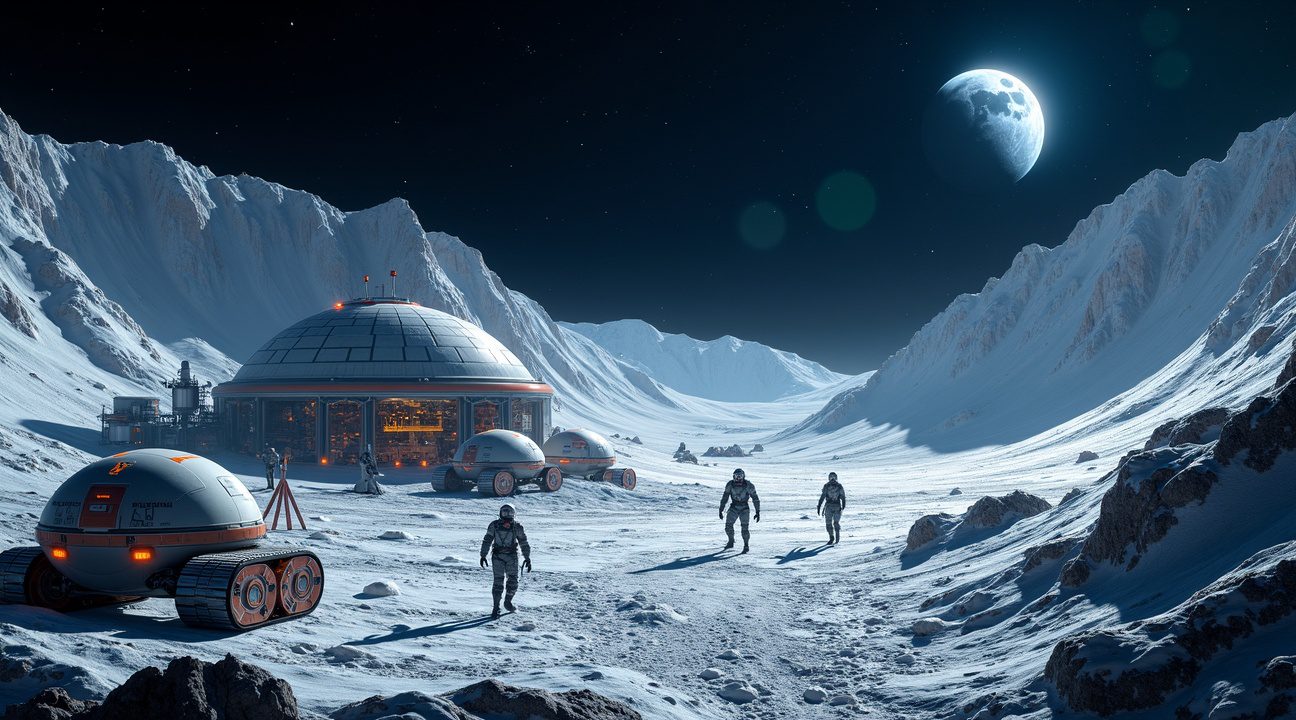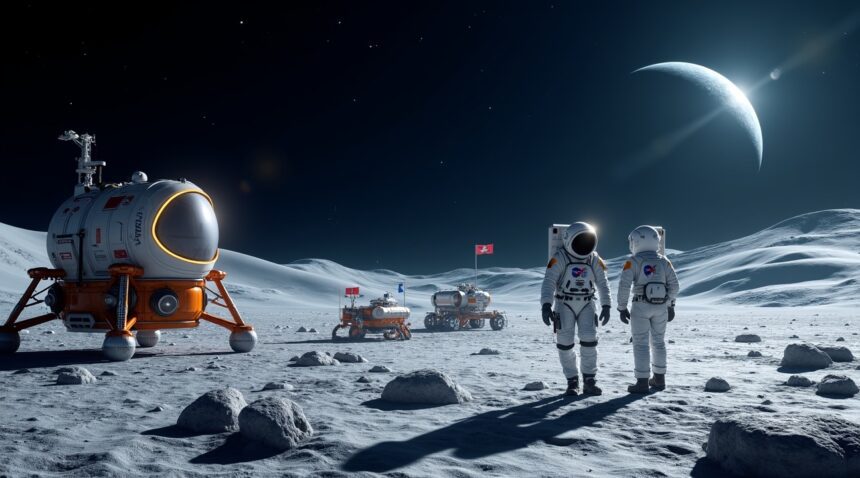NASA’s Artemis program is revolutionizing space exploration by establishing the first permanent lunar base at the Moon’s South Pole, leveraging sustainable infrastructure and global partnerships to prepare humanity for future missions to Mars.
Key Takeaways
- Historic diversity milestone: Artemis III, launching by 2027, will land the first woman and the first person of color on the Moon. The mission will focus on the South Pole, an area rich in water ice critical for long-term habitation and exploration.
- Permanent infrastructure approach: Unlike the short-term Apollo missions, Artemis is designed for longevity. Key elements such as the Surface Habitat, Lunar Terrain Vehicle, and Pressurized Rover are built for continuous operation over at least a decade.
- Strategic stepping stone missions: The program advances in phases—starting with Artemis I’s successful uncrewed lunar test flight in 2022, followed by Artemis II’s crewed lunar flyby projected for 2026—to ensure all systems are validated ahead of establishing the Artemis Base Camp.
- International collaboration framework: The Artemis program is a multilateral initiative with key contributions from agencies such as ESA (European Space Agency), JAXA (Japan Aerospace Exploration Agency), Canada, and the UAE. These partners are providing technologies like advanced robotics, life support systems, and the Gateway orbital station, which will act as the mission’s operational hub. Learn more about the Gateway on NASA’s Gateway overview page.
- Mars mission preparation: Leveraging lunar resources, Artemis will test water ice extraction and conversion into fuel and oxygen—critical steps for enabling human missions to Mars and beyond, establishing the Moon as a sustainable off-Earth logistics base.
First Woman and Person of Color to Walk on Lunar Surface by 2027
The Artemis program represents a historic leap forward in space exploration diversity, with plans to land the first woman and first person of color on the Moon’s surface. This achievement will shatter barriers that have existed since the Apollo era, demonstrating NASA’s commitment to inclusive exploration while advancing scientific discovery.
Breaking New Ground in 2027
Artemis III carries the ambitious timeline of no earlier than mid-2027 for this groundbreaking mission. The carefully selected crew will make history as they step onto lunar soil, marking the first human return to the Moon since Apollo 17 in 1972. This mission prioritizes both scientific advancement and representation, ensuring that space exploration reflects the diversity of humanity itself.
The mission targets the lunar South Pole, a region that holds immense scientific promise due to its unique characteristics. Unlike the equatorial regions explored during Apollo missions, the South Pole contains craters that remain in perpetual shadow, potentially harboring water ice deposits that could prove invaluable for future lunar operations. These resources could support:
- Long-term habitation
- Fuel production for deeper space missions
This makes the South Pole a critical location for establishing a permanent lunar presence.
Strategic Landing Site Selection
NASA has identified thirteen candidate regions near the Moon’s South Pole for these initial missions. Each location was carefully evaluated based on several crucial factors that will determine mission success. The selection criteria include:
- Scientific value
- Resource potential
- Operational feasibility for landing and surface activities
The scientific value of these regions extends beyond their potential water ice deposits. These areas offer unique geological formations that could provide insights into the Moon’s formation and early solar system history. Permanently shadowed regions preserve ancient materials that haven’t been altered by solar radiation, creating natural laboratories for lunar research.
Resource potential remains equally important for mission planning. Water ice represents more than just scientific curiosity – it’s a game-changing resource. It can be used for:
- Conversion into hydrogen and oxygen for rocket fuel
- Drinking water for astronauts
- Agricultural systems for long-term lunar habitation
Harnessing these resources could significantly reduce the cost and complexity of future missions by minimizing dependence on Earth-based supplies.
The timing of this historic mission aligns with broader space exploration initiatives worldwide. While India takes a leap with its own lunar missions and SpaceX launch marks significant milestones in commercial spaceflight, Artemis III will establish American leadership in sustainable lunar exploration.
The mission’s focus on diversity reflects NASA’s understanding that space exploration benefits from varied perspectives and experiences. By ensuring that the first woman and first person of color join this historic achievement, the agency acknowledges that innovation thrives when teams represent different backgrounds and viewpoints. This approach strengthens mission success while inspiring future generations from all communities to pursue careers in science, technology, engineering, and mathematics.
The South Pole landing sites present unique challenges that will test both crew capabilities and technological systems. These include:
- Extended periods of darkness
- Extreme cold temperatures
- Rugged and difficult terrain
These same challenges make the mission’s success even more meaningful, demonstrating humanity’s ability to adapt and thrive in hostile environments beyond Earth.
As the 2027 target date approaches, preparation intensifies across multiple fronts. Astronaut training programs are tailored to the specific demands of South Pole operations, and engineers are refining landing systems capable of precise placement in challenging terrain. The mission represents not just a return to the Moon, but a fundamental shift in how humans approach lunar exploration – with sustainability, diversity, and scientific discovery as core principles guiding every decision.
Building Artemis Base Camp for Two-Month Missions and Decade-Long Use
NASA’s Artemis Base Camp represents a revolutionary approach to lunar exploration, engineered to support extended missions lasting up to two months while maintaining operational capability for at least a decade. This sustainable infrastructure will accommodate both government astronauts and commercial crews, establishing humanity’s first permanent foothold on the Moon’s surface.
Essential Components of the Lunar Base
The base’s foundation centers on three critical systems that work together to enable long-term lunar operations:
- The Surface Habitat (SH) functions as the primary living quarters, providing astronauts with a safe, pressurized environment for extended stays away from Earth.
- The Lunar Terrain Vehicle (LTV) serves as an unpressurized rover capable of carrying 800 kg of cargo and traveling 20 km per charge.
- The Pressurized Rover (PR) extends operational range significantly, allowing crews to conduct multi-day missions tens of kilometers from the base while maintaining life support.
The LTV demonstrates impressive engineering capabilities, operating for 8 continuous hours during each lunar day while withstanding the extreme temperature variations of lunar night. Engineers designed this vehicle to navigate challenging terrain, handling slopes of up to ±20° across the Moon’s rugged landscape. These specifications enable crews to explore previously inaccessible areas and conduct comprehensive scientific research.
Commercial partnerships drive the development of these essential vehicles, with NASA awarding substantial contracts to leading aerospace companies. Intuitive Machines received $1.692 billion for their LTV development, while Lunar Outpost secured $1.727 billion and Astrolab obtained $1.928 billion for their respective contributions. This competitive approach ensures multiple viable solutions while accelerating technological advancement.
The Pressurized Rover represents a significant leap in lunar mobility, extending the operational envelope far beyond what previous missions achieved. Unlike the Apollo lunar modules that required return to base each day, this system enables multi-day expeditions with full life support capabilities. Crews can venture tens of kilometers from Artemis Base Camp, conducting extended geological surveys and establishing remote research stations.
This infrastructure supports new era space exploration by creating reusable assets that reduce mission costs over time. Rather than building new equipment for each mission, teams can utilize established facilities and vehicles repeatedly, maximizing return on investment while advancing scientific understanding of lunar resources and environments.
The decade-long operational timeline ensures sustained human presence on the Moon, enabling continuous research and development activities. This approach contrasts sharply with previous short-duration missions, allowing for comprehensive studies of lunar geology, resource extraction, and technology validation that will prove essential for future Mars missions.

Stepping Stone Missions Leading to Permanent Moon Base
NASA’s approach to establishing a permanent lunar presence follows a carefully planned sequence of increasingly complex missions. Each step builds upon previous achievements while testing critical systems needed for sustained human operations on the Moon’s surface.
Foundation Missions Testing Core Systems
Artemis I marked the beginning of this ambitious journey in 2022. This uncrewed test mission put the Space Launch System (SLS) and Orion spacecraft through their paces during a 25-day odyssey that included six days in lunar orbit within 130 kilometers of the surface. I witnessed how this mission validated the fundamental architecture that will carry astronauts back to the Moon.
The upcoming Artemis II mission, scheduled for April 2026, represents a significant leap forward. Four astronauts will become the first humans to travel around the Moon since the Apollo era. This crewed mission will test life support and deep space systems under real conditions while validating operational readiness for future landing missions. The crew will experience the challenges of deep space travel firsthand, providing invaluable data about human performance during extended lunar missions.
Advanced Launch and Transport Systems
The Space Launch System stands as NASA’s largest rocket and serves as the core launch system for Artemis missions. This powerful vehicle provides the thrust needed to propel Orion and its crew beyond Earth’s gravitational influence. Meanwhile, Orion functions as the main crew transport spacecraft, designed specifically for deep space conditions with advanced life support and mission systems.
NASA has smartly diversified its launch capabilities to boost redundancy and involve commercial participation. Additional heavy launch vehicles like SpaceX Super Heavy and Blue Origin New Glenn are being integrated for cargo and crew landers. This multi-provider approach mirrors the recent SpaceX launch successes that have revolutionized space access.
Parallel lunar lander systems are under development by both SpaceX and Blue Origin to ensure reliability and promote healthy competition. These systems will complement NASA’s own hardware while providing backup options should technical issues arise. The competition between these companies drives innovation while reducing costs, much like how other nations are pursuing their own ambitious lunar programs, including India’s lunar missions and even Dubai’s massive moon project.
The step-by-step progression from Artemis I through future missions creates a foundation for permanent lunar habitation. Each mission tests specific technologies and procedures that will become routine operations at the eventual Moon base. Life support systems validated during Artemis II will inform the design of permanent habitation modules. Landing systems tested during crew missions will evolve into regular cargo delivery platforms.
These stepping stone missions also establish the operational procedures needed for sustained lunar presence. Crews will practice spacewalks, equipment deployment, and emergency protocols that will become standard procedures at the permanent base. The experience gained from each mission feeds directly into the design and operational planning for long-term lunar facilities.
NASA’s systematic approach ensures that by the time astronauts establish the first permanent Moon base, they’ll have thoroughly tested every critical system. From launch vehicles to life support, from navigation to emergency procedures, each component will have proven itself during these preparatory missions. This methodical progression minimizes risk while building the expertise needed for humanity’s next giant leap into permanent lunar settlement.
Gateway Space Station as Lunar Mission Command Hub
I’ve been closely following how NASA’s Gateway station will revolutionize lunar missions by serving as an orbital command center. This innovative space station won’t maintain a permanent crew, but it’ll function as the critical logistics and research hub that makes sustained Moon operations possible.
The Gateway operates as a strategic transfer point where spacecraft can dock, refuel, and coordinate before continuing to the lunar surface or returning to Earth. Its unique lunar orbit position allows for efficient mission planning and resource management that traditional Earth-based operations simply can’t match.
Essential Gateway Components
The station’s architecture consists of three primary modules that work together to support complex lunar missions:
- HALO (Habitation and Logistics Outpost) forms the backbone of operations, housing the main command center alongside life support systems and research facilities. This module ensures astronauts have everything needed for extended stays while coordinating surface missions.
- I-HAB (International Habitation) complements HALO by providing the primary living and working spaces for visiting crews. This international module demonstrates how global partnerships can advance space exploration, offering comfortable quarters and workspace for astronauts during their lunar mission phases.
- ESPRIT rounds out the core infrastructure by delivering advanced communications capabilities, refueling systems, and observation equipment. This European-contributed module ensures Gateway maintains constant contact with Earth while providing the fuel storage necessary for ongoing operations.
International Collaboration and Robotics
Canada’s participation through Canadarm3 showcases how strategic partnerships benefit all involved parties. This advanced robotic system will handle external maintenance, cargo transfers, and precise docking operations that human spacewalks couldn’t safely accomplish. In exchange for this technology, Canada secured two astronaut flight opportunities plus access to robotics development contracts and commercial space ventures.
The Gateway’s design reflects lessons learned from decades of space station operations, incorporating automated systems that reduce crew workload while maximizing mission efficiency. Unlike the International Space Station’s permanent presence, Gateway’s flexible crewing model allows for targeted mission support without the constant resource drain of maintaining full-time inhabitants.
This orbital hub connects directly to broader space exploration initiatives, including SpaceX launch programs that demonstrate how commercial partnerships accelerate space development. Gateway represents a crucial stepping stone for humanity’s expansion beyond Earth, providing the infrastructure foundation that future lunar bases will depend upon for supplies, crew rotation, and emergency support.

Global Partnership Powers Moon Base Construction
The Artemis program represents humanity’s most collaborative approach to lunar exploration, bringing together space agencies from around the world to establish a permanent presence on the Moon. ESA (Europe), JAXA (Japan), CSA (Canada), and the UAE have all committed significant resources, technologies, and astronaut expertise to make this ambitious vision a reality. This international cooperation stands in stark contrast to the competitive space race era and demonstrates how modern space exploration has evolved into a truly global enterprise.
International Contributions Shape Mission Success
Each partner nation brings unique capabilities that strengthen the overall mission architecture.
- Canada contributes advanced robotics systems.
- Japan provides cutting-edge life support technologies and scientific instruments.
- European Space Agency delivers critical service modules and propulsion systems.
- UAE contributes both technological innovation and astronaut participation.
These collaborative efforts ensure that no single nation bears the full burden of establishing humanity’s lunar foothold, while simultaneously advancing each partner’s own space capabilities.
Permanent Infrastructure Replaces Short-Term Visits
Unlike the Apollo missions that focused on brief lunar stays lasting only days, Artemis prioritizes long-duration habitation and sustainable infrastructure development. The program centers around reusable modular components, including the Gateway lunar station that will serve as a staging point for surface operations. Remote rovers and autonomous systems will work continuously to prepare landing sites, extract resources, and maintain equipment even during crew absences. This infrastructure-first approach mirrors successful commercial space initiatives that emphasize reusability and cost-effectiveness.
The partnership extends beyond governmental agencies to include commercial entities that provide launch services, habitat modules, and specialized equipment. This public-private collaboration accelerates development timelines while reducing costs through competitive innovation.
Companies contribute everything from landing systems to life support technologies, creating a diverse ecosystem of lunar infrastructure providers.
The modular design philosophy allows for incremental expansion of the Moon base as missions progress.
- Initial crews will establish basic habitation modules.
- This will be followed by research laboratories and resource extraction facilities.
- Eventually, manufacturing capabilities will be added.
This phased approach ensures that each mission builds upon previous achievements, creating a self-sustaining lunar colony that supports both scientific research and preparation for future Mars exploration.
Water Ice Discovery Powers Mars Mission Preparations
Water ice at the lunar South Pole represents one of the most significant discoveries for humanity’s expansion into deep space. I view this resource as the foundation that will enable NASA’s Artemis program to transform lunar exploration from temporary visits into permanent settlement. The frozen deposits hidden in permanently shadowed craters contain billions of gallons of water that can sustain human life and fuel ambitious missions to Mars.
Critical Technologies for Deep Space Survival
The Artemis program focuses on developing four essential technologies that will prove vital for Mars exploration:
- In-situ resource utilization systems that convert lunar water ice into drinking water, oxygen for breathing, and hydrogen fuel for rockets
- Advanced power generation systems designed to function through 14-day lunar nights with temperatures reaching -230°F
- Habitat designs that protect astronauts from radiation while maintaining comfortable living conditions for extended periods
- Sophisticated robotics capable of mining, processing, and maintaining equipment with minimal human intervention
Each technology addresses specific challenges that astronauts will face during the multi-year journey to Mars and subsequent surface operations. I recognize that mastering these systems on the Moon provides a crucial proving ground before committing to interplanetary missions.
The strategic importance of lunar water ice extends far beyond basic survival needs. Splitting water molecules produces hydrogen and oxygen – the exact propellants needed for rocket fuel. This capability eliminates the enormous cost and complexity of transporting fuel from Earth for Mars-bound spacecraft. SpaceX missions and other commercial ventures will benefit significantly from this lunar fuel depot concept.
NASA plans to establish the Moon base as humanity’s first permanent off-world settlement, creating a stepping stone for Mars exploration. The base will serve multiple functions: a research laboratory, a technology testing facility, and a refueling station for deep space missions. I see this approach as fundamentally different from the Apollo program’s brief surface visits.
The lunar environment provides unique advantages for Mars mission preparation. Gravity at one-sixth of Earth’s level allows astronauts to adapt gradually to reduced gravity conditions they’ll experience on Mars. The vacuum of space, extreme temperatures, and radiation exposure mirror many challenges of interplanetary travel. Successfully operating equipment and life support systems for months on the Moon builds confidence for the years-long Mars missions.
Power generation represents one of the most challenging aspects of permanent lunar habitation. Solar panels must survive temperature swings of nearly 500°F between lunar day and night cycles. Advanced battery systems and potentially nuclear reactors will provide continuous power during the two-week lunar nights. These same technologies will prove essential for Mars missions, where dust storms can block sunlight for months.
Habitat design innovations developed for the Moon base will directly influence Mars mission architecture. Structures must protect inhabitants from cosmic radiation while maintaining psychological well-being during isolation. The Moon’s proximity to Earth allows rapid communication for troubleshooting and emergency support – luxuries unavailable during Mars missions separated by millions of miles.
Robotic systems play an increasingly important role in Artemis operations. Autonomous rovers will scout water ice deposits, prepare landing sites, and maintain equipment between crewed missions. International lunar missions contribute valuable data about optimal locations for these robotic operations.
The timeline for Mars missions depends heavily on Artemis program success. NASA envisions lunar base operations beginning in the late 2020s, providing approximately a decade of operational experience before launching crewed Mars missions. This extended testing period allows engineers to refine life support systems, improve equipment reliability, and develop standard operating procedures for deep space exploration.
Water ice mining operations will begin with small-scale extraction to support initial base operations. As technology matures and demand increases, industrial-scale processing facilities will produce enough fuel for regular Mars mission launches. The economic benefits of lunar fuel production could revolutionize space exploration by dramatically reducing mission costs.

Sources:
Wikipedia – Artemis program
Royal Museums Greenwich – NASA’s Artemis moon missions: All you need to know
Astronomy Magazine – How Artemis will land humans on the moon
CityLabs – The Artemis Mission and the Future of Lunar Science
Canadian Space Agency (CSA) – The Artemis campaign
NASA – Artemis II
NASA – Meet NASA’s Artemis II Moon Mission Masterminds


